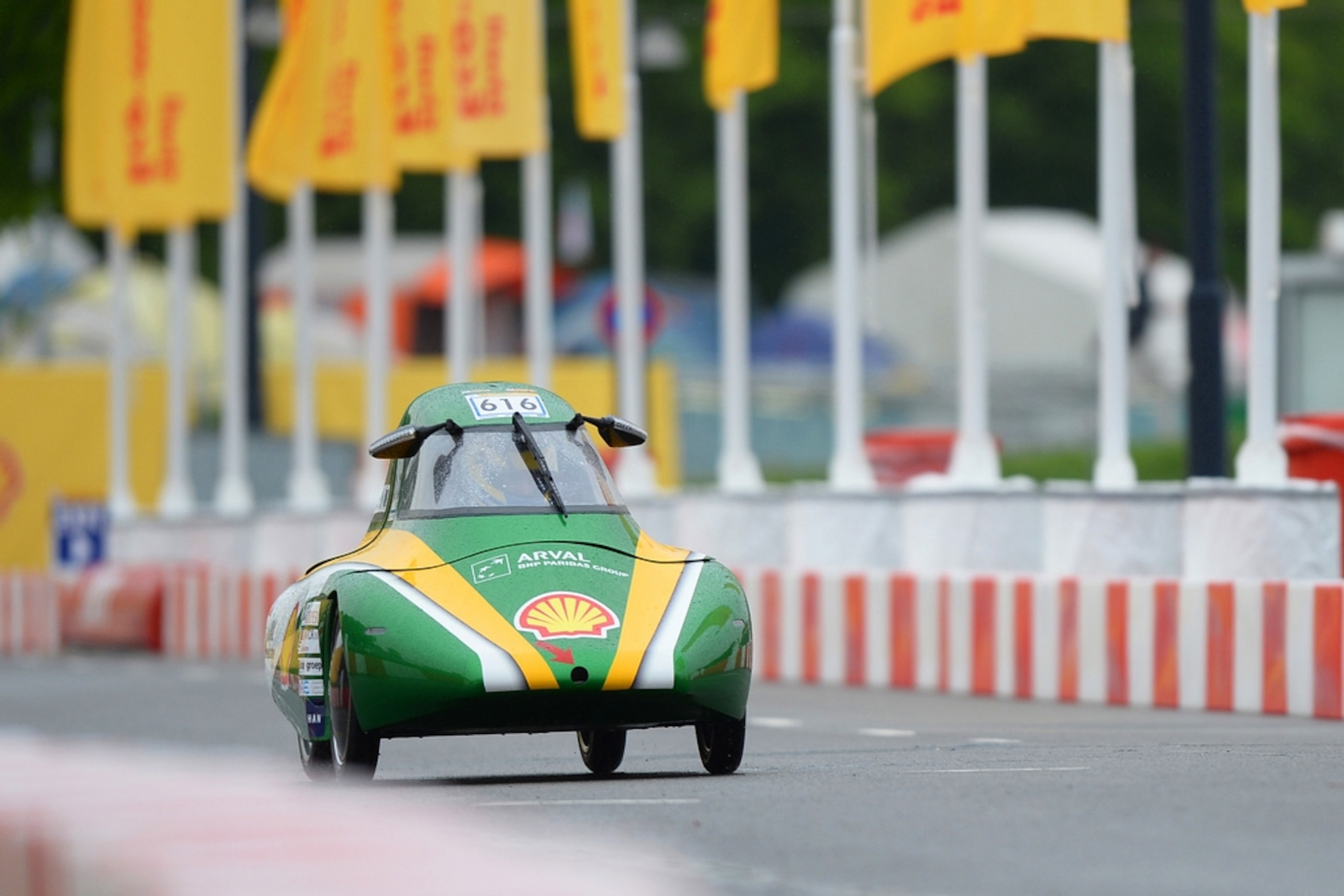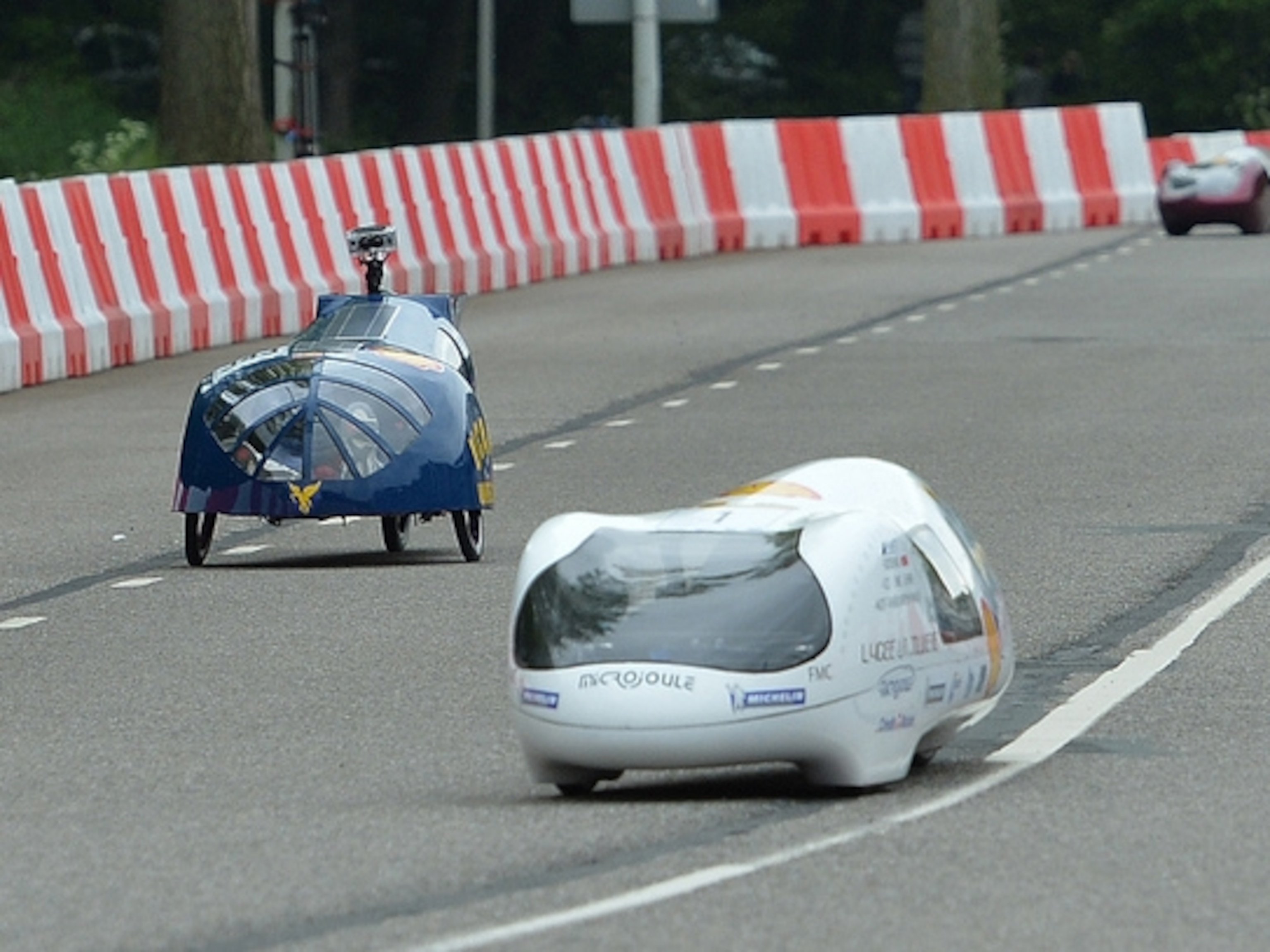More than 3,000 students from 27 countries compete this weekend in what is without a doubt the slowest racing competition in the world. Speed is nothing to brag about in the 30th edition of the Shell Eco-marathon Europe: It’s all about fuel efficiency.
Slowly but surely, 198 student teams drive their self-built cars over a 1-mile (1.6 km) street circuit in Rotterdam, averaging 15.6 miles an hour (25 km/h). With speed out of the equation, the only way to win the competition is by efficient design, innovative technology, and a sophisticated driving strategy.
Last year’s winner, Team Microjoule from the technical school La Joliverie in Saint-Sébastien-sur-Loire, France, completed the mandatory ten laps with a calculated fuel consumption of 2,980 kilometers on a single liter of gasoline (7,000 miles per gallon). Already on the first day of this year’s competition, the team broke the magical 3,000 kilometer barrier with a score of 3,191 kilometers (1,982 miles)—the circuit record.
“We spent all year improving our car. New materials in the tires and a better steering system should make it even more fuel efficient,” Guillome Hinsworth said while waiting in line at the start of the circuit for what would become a record breaking run. “And the weather is much better this year. It’s dry and warm, so there’s a lot less rolling resistance compared to last year.”
The marathon features futuristic looking cars in two categories: the sleek aerodynamic cigars-on-wheels of the prototype class, and the four-wheeled urban concept cars that resemble something you could see people driving on the road one day. Fuels range from conventional—gasoline, diesel, ethanol and the synthetic diesel GTL—to hydrogen and full electric.

For some teams, creating Europe’s most fuel efficient car simply isn’t enough of a challenge. They want to take their car out on the streets to show the world what mobility will look like in the future.
The Dutch teams HAN Hydromotive and TU/Ecomotive applied for a road license from the department of motor vehicles RDW. They had to make some alterations to the car to improve safety, but got their plates and drove all the way to the start line of the competition in Rotterdam from their home towns of Arnhem and Eindhoven.
Their cars catch the eye of many visitors of the Eco-marathon, adults and children alike. At first 12-year-old Ennes Yildiz didn’t know what to make of the weird looking vehicles. After hearing the story behind the road trip to Rotterdam he concludes: “The race is a good idea, because this way you don’t waste gasoline. That’s much better for the environment and it costs less money.”
*Shell is sponsor of the Great Energy Challenge. National Geographic maintains autonomy over content.
Related Topics
You May Also Like
Go Further
Animals
- Octopuses have a lot of secrets. Can you guess 8 of them?
- Animals
- Feature
Octopuses have a lot of secrets. Can you guess 8 of them? - This biologist and her rescue dog help protect bears in the AndesThis biologist and her rescue dog help protect bears in the Andes
- An octopus invited this writer into her tank—and her secret worldAn octopus invited this writer into her tank—and her secret world
- Peace-loving bonobos are more aggressive than we thoughtPeace-loving bonobos are more aggressive than we thought
Environment
- Listen to 30 years of climate change transformed into haunting musicListen to 30 years of climate change transformed into haunting music
- This ancient society tried to stop El Niño—with child sacrificeThis ancient society tried to stop El Niño—with child sacrifice
- U.S. plans to clean its drinking water. What does that mean?U.S. plans to clean its drinking water. What does that mean?
- Food systems: supporting the triangle of food security, Video Story
- Paid Content
Food systems: supporting the triangle of food security - Will we ever solve the mystery of the Mima mounds?Will we ever solve the mystery of the Mima mounds?
History & Culture
- Strange clues in a Maya temple reveal a fiery political dramaStrange clues in a Maya temple reveal a fiery political drama
- How technology is revealing secrets in these ancient scrollsHow technology is revealing secrets in these ancient scrolls
- Pilgrimages aren’t just spiritual anymore. They’re a workout.Pilgrimages aren’t just spiritual anymore. They’re a workout.
- This ancient society tried to stop El Niño—with child sacrificeThis ancient society tried to stop El Niño—with child sacrifice
- This ancient cure was just revived in a lab. Does it work?This ancient cure was just revived in a lab. Does it work?
Science
- The unexpected health benefits of Ozempic and MounjaroThe unexpected health benefits of Ozempic and Mounjaro
- Do you have an inner monologue? Here’s what it reveals about you.Do you have an inner monologue? Here’s what it reveals about you.
- Jupiter’s volcanic moon Io has been erupting for billions of yearsJupiter’s volcanic moon Io has been erupting for billions of years
- This 80-foot-long sea monster was the killer whale of its timeThis 80-foot-long sea monster was the killer whale of its time
Travel
- How to plan an epic summer trip to a national parkHow to plan an epic summer trip to a national park
- This town is the Alps' first European Capital of CultureThis town is the Alps' first European Capital of Culture
- This royal city lies in the shadow of Kuala LumpurThis royal city lies in the shadow of Kuala Lumpur
- This author tells the story of crypto-trading Mongolian nomadsThis author tells the story of crypto-trading Mongolian nomads




